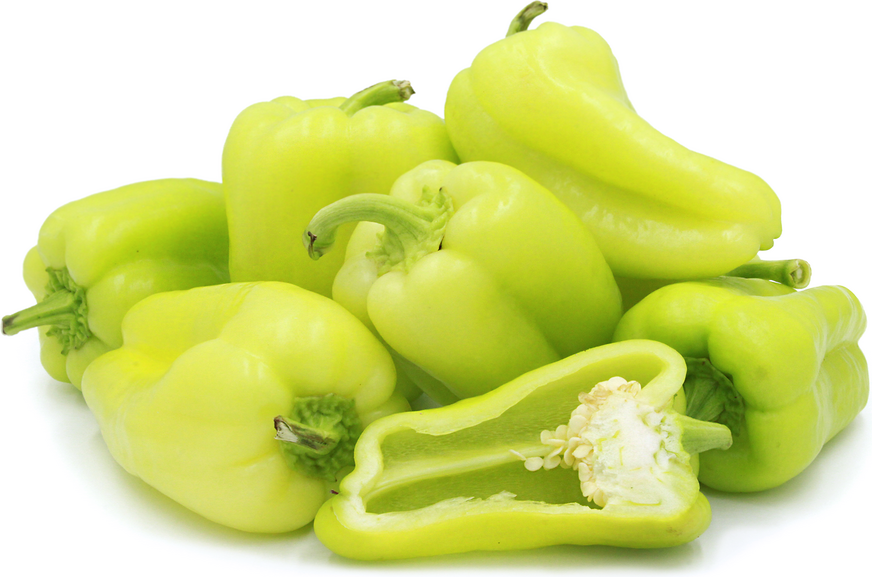


Gypsy Bell Peppers
Estimated Inventory, lb : 0
Description/Taste
Gypsy peppers are small to medium in size, averaging ten centimeters in length and five centimeters in diameter, and have narrow shoulders with an elongated, tapered shape, similar in appearance to the shape of a jalapeno. The thin skin transitions from a pale yellow-green to a deep orange-red with maturity and is firm, smooth, and taut. Underneath the skin, the pale green flesh is crisp, juicy, and succulent with a wide, hollow cavity filled with many small, cream-colored seeds. When young and green, Gypsy peppers are crunchy and have a slightly acidic flavor. As they mature, Gypsy peppers develop a complex, sugary sweet taste with subtle floral notes.
Seasons/Availability
Gypsy peppers are available in the summer through late fall.
Current Facts
Gypsy peppers, botanically classified as Capsicum annuum, are a hybrid variety belonging to the Solanaceae or nightshade family. The peppers are also known as Cubanelle peppers, and are a hand-bred cross between a sweet pepper and a bell pepper. Gypsy peppers are a popular home garden variety in the United States, favored for their thin skin, sweet flavor, and ability to be harvested at any stage in maturity. The Gypsy pepper plant is also a prolific producer, yielding 50 to 100 peppers in a season, allowing home cooks large harvests for both fresh and pickled preparations. In the early 21st century, the peppers expanded beyond home cultivation and found a niche market within restaurants as a quick-cooking sweet pepper.
Nutritional Value
Gypsy peppers are an excellent source of vitamins A and C, which are antioxidants that can help strengthen the immune system and reduce inflammation. The peppers are also a good source of vitamin B6 and folate, and provide manganese, potassium, copper, and vitamin K.
Applications
Gypsy peppers are best suited for both raw and cooked applications such as frying, roasting, or stuffing and can be used at any stage of ripeness, from pale green to red-orange. The pale-colored young peppers are well-suited for Eastern European recipes, whereas the mature red ones are much sweeter and pair well with Mediterranean recipes. Gypsy peppers are good for stuffing because unlike the thick walls of bell peppers, the thinner skin cooks more evenly and is less likely to be undercooked when the stuffing is through cooking. The thin-skinned Gypsy pepper is also ideal for frying or roasting because they don’t require peeling. Gypsy peppers can be used fresh and added to sandwiches, salads, or used in dips. They can also be diced and sautéed, charred for a smoky sweetness, or chopped and mixed into stir-fries. Gypsy peppers pair well with grilled fish, poultry, pancetta, corn, shallots, garlic, red onions, paprika, manchego cheese, parmesan cheese, bread pudding, panko breadcrumbs, basil, thyme, Italian parsley, mixed baby greens, and tomatoes. The peppers will keep 1-2 weeks when stored unwashed, wrapped in damp paper towels, and sealed in a container in the refrigerator.
Ethnic/Cultural Info
The company that developed Gypsy sweet peppers, Petoseed, was founded in 1950 in Southern California and was a leader in the hybridization of hot peppers and tomatoes in the 1970s and 1980s. The seed company was a major producer of disease-resistant seed varieties. Petoseed is credited with the recovery of San Diego’s tomato industry after the development of a tomato hybrid that was resistant to a disease that had nearly wiped out the area in the early 1970s. The Gypsy pepper was developed to resist a common pepper plant disease, the tobacco mosaic virus, or tobamovirus and in 1981, the pepper was given the distinction of National All-American Selection for its quality growth characteristics.
Geography/History
Gypsy peppers were developed in the United States by Petoseed Co. in 1980, from a cross between a bell pepper and a sweet Italian bull horn pepper. Today Gypsy peppers are primarily grown by small farms and are available through farmer’s markets and specialty grocers in the United States and Mexico.
Recipe Ideas
Recipes that include Gypsy Bell Peppers. One
| Food 52 |
|
The Mature Gypsy (Stuffed) |
| Farm Fresh to You |
|
Gypsy Pepper Rice Pilaf |













